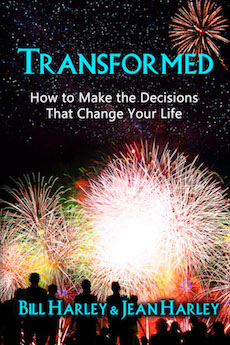By Bill Harley
I’ve blogged before about the practice of “Dispassionate Disagreement”, which is introduced in Jean’s and my second book, TRANSFORMED: How to Make the Decisions That Change Your Life. Being able to disagree in a dispassionate way is an important part of finding truth as we consult together. A number of our readers have asked for more clarification on this subject to support their use of the revolutionary process called Compassionate Consultation for making decisions and solving problems in groups (or alone).
“Dispassionate Disagreement” sounds like an oxymoron to people who live in a culture where “passionate disagreement” is the norm; but not getting to the truth of a matter is also the norm in such a culture. One way to think of this is that your lower nature, your ego-driven self, is competitive and prefers passionate disagreement; while your higher nature, your true self, is compassionate, collaborative and prefers dispassionate disagreement. Our book and the previous blog illustrate how maintaining both dispassionate disagreement and an atmosphere of compassion among the deliberating group members are critical to effectively searching out and revealing the truth of a given situation—otherwise the truth remains hidden. These qualities and others create a culture, climate and energy frequency conducive to truth-seeking and truth-finding with the members’ true selves in the lead.
Our previous blog on this subject explained that “Those who are skilled at Dispassionate Disagreement have a different approach to the clash of ideas. They don’t focus on the thought collisions and how to win the argument; they focus on the sparks emanating from the thought collisions that illuminate new terrain leading to the truth and transformative solutions. They are dispassionate about the clash of ideas, but passionate about the collaborative search for truth.” In that blog, we also illustrated how dispassionate disagreement would allow us to create a truly balanced, effective social welfare system.
A Lesson from Astronomy—Looking Indirectly At the Clash of Differing Opinions
Another way to understand dispassionate disagreement is to think of it as the ability to look indirectly at, or slightly off to the side of, the clash of differing opinions for the spark of new insight, illumination and guidance that may appear. The field of astronomy holds a relevant lesson. If we attempt to look into the dark sky directly at a particular star, it is almost impossible to see it clearly. This is because the starlight falls on the cones in the retinas of our eyes when we look directly at the star; and, while the cones see color, they are not as sensitive at seeing light as the rods in our eyes. However, when we look indirectly at, or slightly off to the side of, the star, we can see the star more clearly because now the starlight falls on the rods in the retinas of our eyes. While the rods only see black and white, they are more sensitive than the cones in the darkness and allow us to see light more clearly. Therefore, when we want to see a point of light clearly in the darkness, we should look off to the side or indirectly at the object.
And this is also true in the Compassionate Consultation process. Combining compassion with consultation is designed for situations when we are in darkness. Bahá’u’lláh, who presented this process to the world, says, “Consultation…is a shining light which, in a dark world, leadeth the way and guideth” (Bahá’u’lláh, quoted in Consultation: A Compilation, p. 3.). Rather than focusing directly on the clash of differing opinions, if we create a Compassionate Consultation culture in which we dispassionately and mindfully look off to the side of the clash, we will not only see the clash more clearly and objectively, but we will also better see the sparks emanating from the clash that illuminate the path to understanding and truth.
Dispassionate Disagreement is just one of 12 Behavioral Standards that inform the revolutionary decision-making process called Compassionate Consultation, which is the deliberation process for the 21st Century and beyond. For the full story, read our second book entitled, TRANSFORMED: How to Make the Decisions That Change Your Life.
















